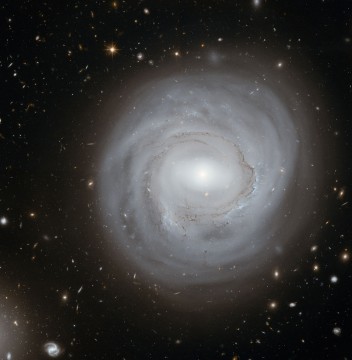
NASA / ESA / K. Cook (Lawrence Livermore National Laboratory, USA)
Observers, experience William Herschel’s “Night of Discovery,” featured in the April 2015 issue of Sky & Telescope, for yourself!
Like the Messier Marathon, the Herschel Sprint can be completed in one moonless night in the spring. Purists can recreate the sweep using an eyepiece that provides a magnification of about 150x, sweeping in a north–south pattern over a 2–3° field as stars drift into view from the east.
Modern eyepieces provide much wider fields of view than the ones Herschel employed. To further authenticate the experience, choose a higher magnification eyepiece that provides a 15–20′ field, or use an older style eyepiece (for example, an orthoscopic with a 45° or 50° field of view). Others may prefer to use a good star atlas or computer-assisted telescope to more quickly locate objects and provide more time to study each one.
You will likely need at least a 15-inch aperture telescope to ensure total success, but observers using smaller telescopes can observe many, if not most, of the objects on the list with little difficulty.
S&T contributor Mark Bratton has compiled an extensive table to guide your quest (download as a .pdf or an Excel file). Let us know via e-mail or by leaving a comment: What is the minimum aperture that reveals all 73 objects? How successful was your spring sprint?
 5
5

Comments
Tom Hoffelder
March 5, 2015 at 8:29 pm
As the first person to see 100 Messier objects in one night (as far as has been documented, http://messier.seds.org/xtra/marathon/results.html#mmhist), I find the Herschel Sprint very interesting, and plan on trying it once Maine weather improves. One comment I have now is that surface brightness can be more meaningful than magnitude, so the first thing I did was download the Excel file (thanks much to whomever added that!) and included those values. Next I compare the surface brightness of these objects to the galaxies in the Herschel II list, since I saw all of the latter in an 8 inch scope (in Oklahoma, not New England). The lowest surface brightness for the H II list is 15.3 and 15.0 for the Sprint. That says all of the Sprint might be visible in an 8 inch, under dark skies of course, but some of them have dimensions less than 1’ (which the H II does not) and that will probably be a factor in 8 to 10 inch scopes. I’m hoping to see all (in about two hours, without go-to) in our C14 and I’ll let you know! Tom Hoffelder
You must be logged in to post a comment.
Tom Hoffelder
March 14, 2015 at 10:46 am
Is it possible that IC 4051 is listed in error. Uranometria 2000 shows it just below NGC 4908. However, if you enter those two in DSS (http://stdatu.stsci.edu/cgi-bin/dss_form), that shows 4908 to be below the IC object. Also, as you would expect, it shows 4908 to be larger and brighter than the IC. It does not seem likely that Herschel would have seen IC 4051, but not NGC 4908.
You must be logged in to post a comment.
Tom Hoffelder
March 14, 2015 at 11:29 am
Well, maybe not. The DSS declination shown for NGC 4908 is +28 00 27.5, which supposedly comes from SIMBAD. But if you go to SIMBAD and enter N4908, it gives +28 02 34.19 as the declination, and +28 00 27.20 for the IC.
You must be logged in to post a comment.
JRPost Author
March 16, 2015 at 8:48 am
Check out Mark Bratton's discussion of IC 4051 and its location in the Herschel sprint article in the April 2015 issue. He makes a good argument for these coordinates!
You must be logged in to post a comment.
April 14, 2015 at 2:55 am
Herschel Sprint two thirds done!
Tonight (April 13) finally provided a window of opportunity to attempt the Herschel Sprint. April 9 and 10, though clear, were compromised by intense auroral activity. April 11 hazed out early, April 12 was mostly cloudy. Tonight, skies were clear at sunset and shortly before 10:00 p.m. (CST) 04:00 (UT) I uncovered my 18" F/4.5 LITEBOX Dobsonian to begin the Sprint. First target, NGC 3196... an extremely difficult galaxy which took the better part of fifteen minutes to confirm. From there, things went very well. Using eyepieces providing magnifications of 52x, 159x, 207x and 295x, I cruised through the early part of the Sprint with little difficulty, though NGC3527 provided something of a challenge. I star-hopped from target to target, working quickly as the Clear Sky Chart indicated that the sky would cloud up by midnight. The triplet NGC4131, NGC4132 and NGC4134 was superb (with a tiny, faint galaxy immediately north of NGC4131 intermittently visible... possibly this was Herschel’s “4th suspected” object in the group. The Hickson 61 galaxy group, immediately following, was delightful. Another challenging object was the diffuse spiral NGC4393 (immediately NNW from 14 Comae). After the graceful spiral NGC4559 it was on into the Coma Cluster with a half dozen Herschel Sprint objects quickly identified. But then... high haze began building shortly before midnight, slowly covering the sky. Repeated efforts to confirm the edge-on galaxy NGC4892 came up short as the haze thickened and the Sprint had to be abandoned. Nevertheless, 52 Sprint objects were observed in 100 minutes... Will try again tomorrow night...
You must be logged in to post a comment.
You must be logged in to post a comment.